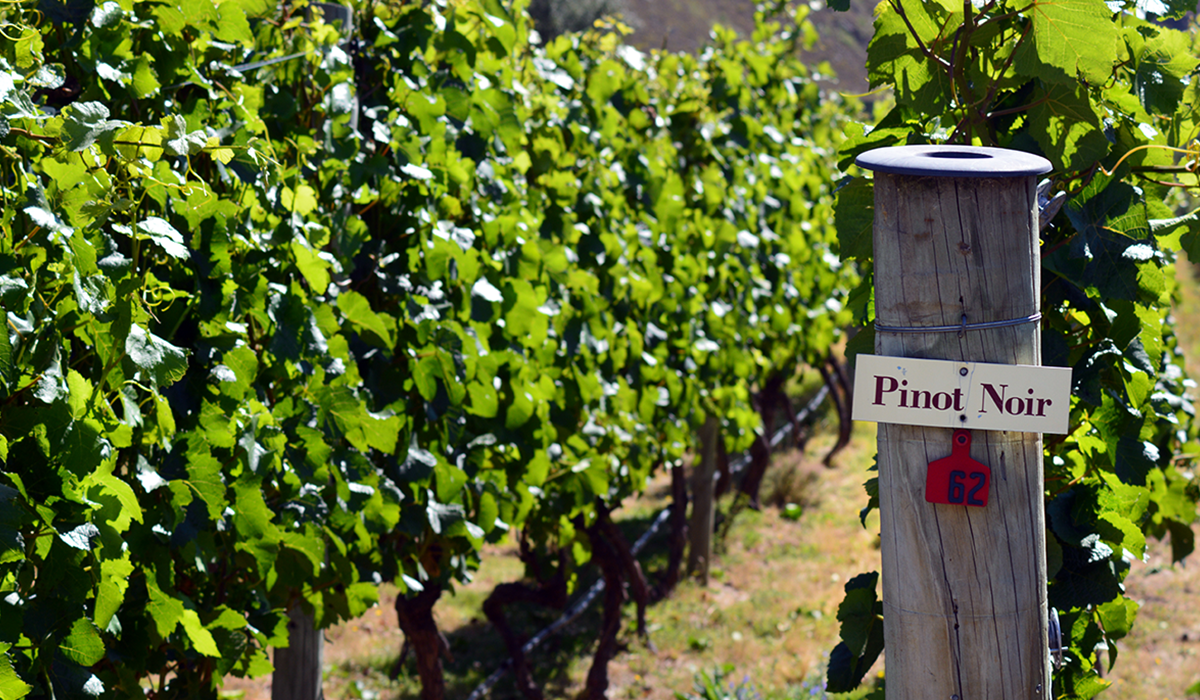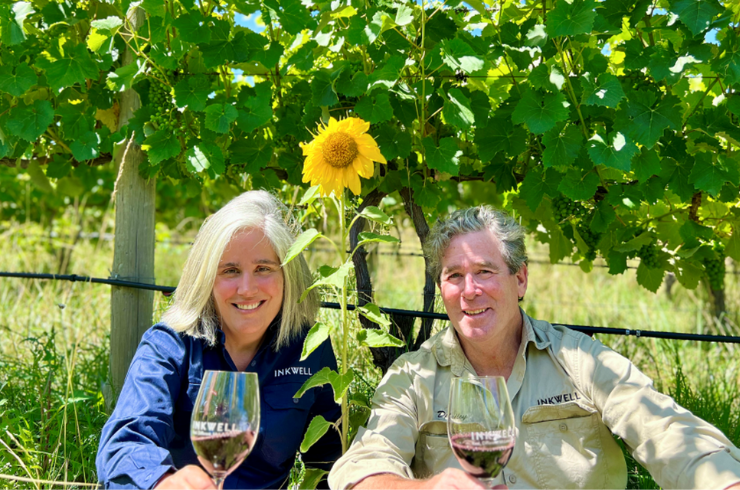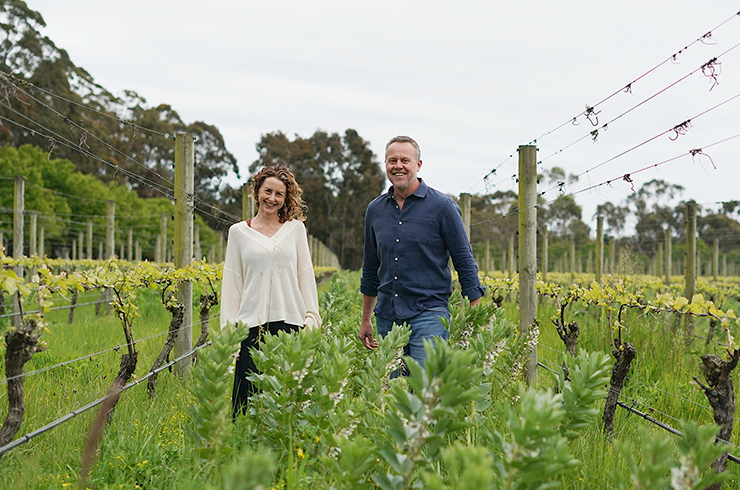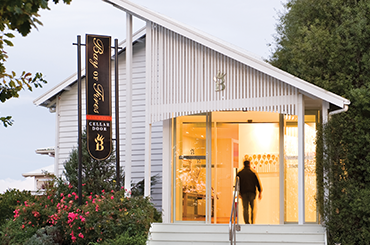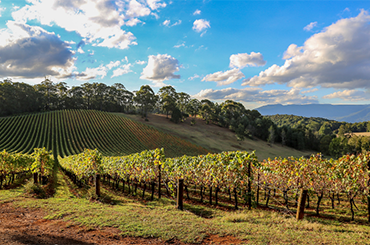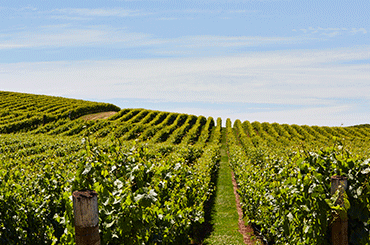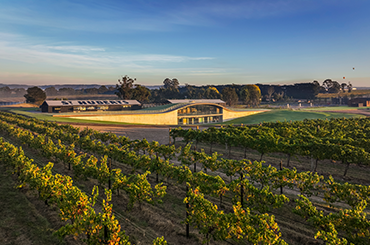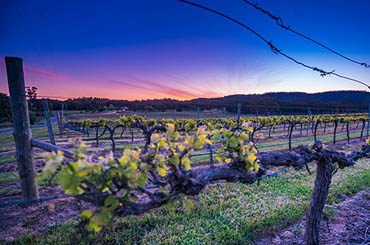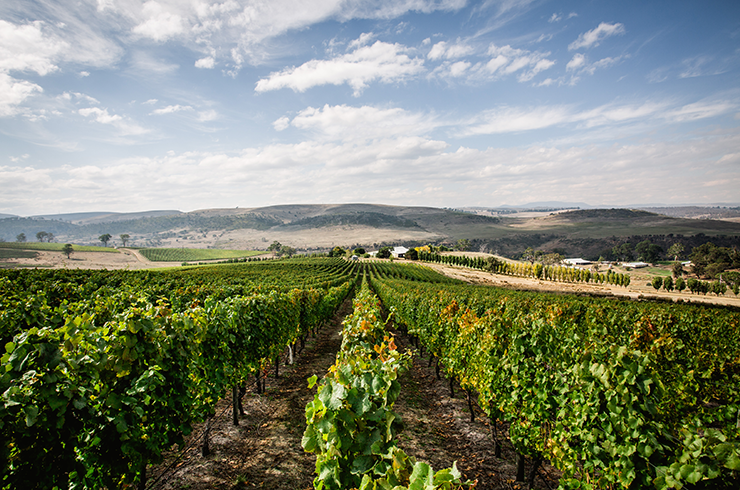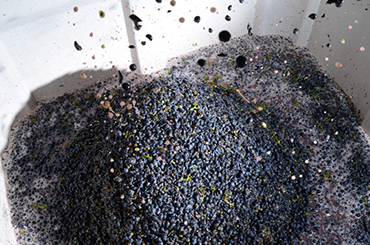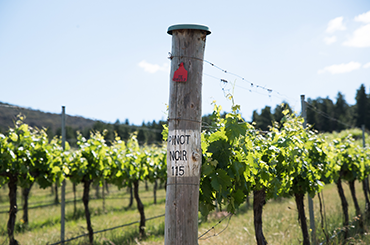Go to section: Pinot noir characteristics | Origins of pinot noir | How to pair food with pinot noir | Serving temperature for pinot noir | The best Australian pinot noir regions
Pinot noir a thin-skinned, light- to medium-bodied black grape variety that is very fussy about where it's grown. While it's a difficult variety for grape growers, it's a very easy wine to drink. Pinot noir has soft tannins, and its tasting characteristics are floral, fruit, earth, and herb and spice. Learn all about this elegant and complex red variety ahead.
Pinot noir tasting characteristics
Pinot noir is a black grape variety with a thin skin and is best suited to a cool to moderate climate. Pinot noir is pale to medium in colour and is high in acidity with fine, soft tannins. Its red fruit flavours include strawberry, cherry, raspberry, cranberry and plum and the freshness will depend on the ripeness of the grape. Pinot noir can also have an earthy palate. For example, the pinot noir made in Tasmania is full of bright red fruit but also boasts mushroom, truffle and forest floor.When tasting, one must remember that pinot noir is not a big red wine. This is a variety that’s tricky to perfect, but once you do, it’s all delicacy and finesse.
Origins of pinot noir
Pinot noir is an ancient grape. The earliest use of the name, then spelled “pinoz”, was recorded in 1375. It’s also a variety with one of the most interesting vinous family histories: until DNA testing in 1993, it was assumed that pinot noir, pinot gris, pinot meunier and pinot blanc were distinct varieties found within the pinot family, but it’s since been confirmed they’re actually mutations of the same genetic footprint.It’s also widely believed pinot is the grandparent of teroldego, marzemino, lagrein and dureza; a parent of savagnin; the grandparent of chenin and sauvignon blanc; and, perhaps most dramatically, a great-grandparent of cabernet sauvignon – an incredible evolution over the last 1000 years.
While pinot noir is now grown across many international sites, its spiritual homeland is undoubtedly Burgundy. Give or take a century or two, Burgundy was pinpointed as a great wine-producing area by the end of the first millennium. Over the next 600 years, the monasteries and monks painstakingly discovered, defined and refined the process for growing the greatest possible pinot noir.
In regards to Australian pinot noir, it’s possible that a clone made its way to Australia with the First Fleet in 1788, and it was definitely part of the collection of vines that James Busby established in the Hunter Valley in the early 1800s. Despite trying and failing to grow pinot noir in South Australia, the variety successfully took off in Victoria, especially in Geelong and the Yarra Valley.
In the 1880s, however, vines were wiped out by phylloxera in Geelong and later by the switch to dairying in the Yarra Valley, and it wasn’t until the 1970s that pinot noir made a comeback. Today, you can find first-class Australian expressions coming out of our cooler climate wine regions.
How to pair food with pinot noir
Pinot noir is one of the most food-friendly red wines. The holy grail of pairings is pinot noir and duck. Ask any winemaker or sommelier and they’ll agree: whether the pinot is cherry-red or a more savoury number, duck is a winner.Don’t be afraid to pair pinot with a touch of spice either. Pinot noir is an excellent accompaniment to lightly spiced Thai dishes or even a mid-morning round of Chinese yum cha. Oily meals such as salmon, tuna or pasta will pair well with a light and dry pinot noir, while the more tannic styles go with richer foods like a beef bourguignon. And don’t forget the cheese. Make sure your platter includes creamy brie, blue and sharp goat’s cheeses, and you’ll be dining (and drinking) well.
Serving temperature for pinot noir
The ideal serving temperature for pinot noir is 14 degrees.-
The best Australian pinot noir tasting notes
-
Pooley Wines
Jack Denis Pooley Pinot Noir 2020
Tasmania -
Giant Steps
Applejack Vineyard Pinot Noir 2021
Yarra Valley -
Ossa Wines
Pinot Noir 2020
Tasmania -
Bannockburn Vineyards
Serré Pinot Noir 2019
Geelong -
Bannockburn Vineyards
De La Terre Pinot Noir 2019
Geelong -
Bass Phillip
Premium Old Vines Pinot Noir 2020
Gippsland -
Lowestoft
La Maison Pinot Noir 2020
Tasmania
The best Australian pinot noir regions
James once said: “The first problem with pinot is that it is the most reluctant traveller of all the classic grape varieties.” He is right, of course. Before 1950, there were only a few hectares – probably less than 100 – spread around the world outside of its ancestral home. But when it finds a home, it settles in for the long run.
Tasmania
It is difficult to know where to start with a state bursting with so much potential and achievement. The Pipers River, Tamar Valley, Derwent, Huon Valley, Richmond/Coal River and East Coast all have ever-increasing numbers of producing making ever-greater pinots. There are significant differences in style linked to the different districts' mesoclimate – the Coal Valley, Upper Derwent, East Coast, Tamar Valley, Richmond and Huon Valley all have different voices.GippslandA moderate climate in the west, and cooler climate in the south and east, the region is a diverse one. A handful of wineries produce pinot noir from rustic to sophisticated, and from lighter- to fuller-bodied.
Geelong
More wind, less rainfall and tougher soils were the background for Gary Farr to fashion the powerful, brooding wines of Bannockburn and Farr, the close-planted Serre Vineyard of Bannockburn the most imperious and worth cellaring. Pinot noir from Geelong is concentrated with good depth. Flavours of dark cherries and green olive fruit.
Henty
Henty is Australia's coolest region, as classified by Dr John Gladstones, and is why pinot noir, riesling and chardonnay are standout varieties. All three varieties are intense and elegant, acidity a given. Mount Gambier is nearly as cool, as it too is a pinot noir haven.
Macedon Ranges
The windiest and coolest of the five regions circling Melbourne, with many of the vineyards better suited to the production of sparkling, rather than table, wine. The elevated region produces pinot noir that shows restraint, finesse and complexity. It can be difficult to achieve full ripe flavour in pinot, but Bindi and Curly Flat show that it can be down with appropriate site selection.
Mornington Peninsula
Overall, the wines are similar to those of the Yarra Valley, perhaps slightly less structured: the climate is a little cooler and wetter, and the harvest dates a week to 10 days later on average. The two outstanding exceptions are Paringa Estate and Yabby Lake, which produce wines of amazing richness and complexity. There there are another dozen or so making silky wines relying on elegance to handsomely make their point. Mornington pinot is approachable when young, and light with elegance and complexity.
Yarra Valley
The best wines from the best vintages have exceptional aroma, finesse, intensity and length. By and large they are made in light- to medium-bodied style, without resorting to over-extraction or excess oak influence. With five years of bottle age they can acquire distinctly Burgundian characteristics.
Great Southern
The Great Southern is home to five sub-regions: Albany, Denmark, Frankland River, Mount Barker and Porongorup. Denmark is the coolest climate, with the largest number of pinot producers, making wines with complex and savoury flavours. Fruit-driven styles come from Mount Barker, and lighter styles from Frankland River.
Pemberton
This cooler region in WA produces complex pinot that is medium-bodied. Tasting characteristics include plum, cassis and mocha.
Adelaide Hills
Slope, aspect and location provide an infinitely complex mosaic, and it is hardly surprising that South Australia's only – and relatively small – regional producer of high-quality pinot noir should provide taut and racy wines. Pinot noir in the Adelaide Hills is rich, with ripe berry and cherry notes.
New South Wales
Small quantities are being grown in the Hunter Valley (and often blended with shiraz), along with the cool climate regions of Orange and Tumbarumba.*Information and quotes are taken from James Halliday’s Varietal Wines.
Image credit: Wine Australia.
Featured wineries
More FromRelated articles
-
Wine Lists
Australian pinot noir to try in 2024
14 Oct 2024 -
Top Rated
Top Rated: Pinot Noir
-
News
Tasmania takes out the 2023 Australian Pinot Noir Challenge
5 Oct 2023 -
Meet the Winemaker
Meet Some Of our Top Pinot Noir Makers
1 May 2019 -
News
Producing pinot noir
8 Jan 2023 -
Top Rated
Best pinot noir in Australia 2025
-
Meet the Winemaker
How to make great pinot noir
12 Jan 2023 -
Wine Lists
Four wines for International Pinot Noir Day
15 Aug 2024
